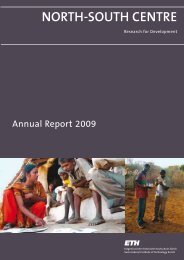Annual Report 2006/07 - ETH - North-South Centre North-South ...
Annual Report 2006/07 - ETH - North-South Centre North-South ...
Annual Report 2006/07 - ETH - North-South Centre North-South ...
Create successful ePaper yourself
Turn your PDF publications into a flip-book with our unique Google optimized e-Paper software.
Research Fellow Partnership Programme (RFPP)Research fellowAtti Tchabi, University of BaselSupervisorsAndres Wiemken, Fritz Oehl,University of Basel /Danny Coyne, IITA, NigeriaCollaboratorsFabien Hountondji, IITA, Benin /Paul Mäder, FiBL, Frick /Robert Asiedu, IITA, NigeriaDurationSeptember 2004 – August 20<strong>07</strong>Indigenous arbuscular mycorrhizal fungi (AMF) fromthe “yam belt” for improved yam growth and reducedyam nematodes infestation in West AfricaYam tubers harvested from yam plantlets (plants) of tropical Dioscoreacayenensis uninoculated (control, above) and inoculated (Ben 10, below) with theindigenous arbuscular mycorrhizal fungi Glomus etunicatum.Yam (Dioscorea spp.) is the most important tuber crop in termsof area coverage in West Africa, particularly in Benin and Togo.Alarmingly, over the last years, the annual yam production perhectare has been decreasing considerably due to a loss of soilfertility and nematode damage. Arbuscular mycorrhiza (AM) isthe most widely occurring symbiosis with higher plants. AMfungi play a major role in plant nutrient assimilation, plantwaterrelations and may provide resistance againstpathogens. This project aims to explore indigenous AM fungiand assessing their effect on yam growth and yam nematodecontrol. About 60 different AM fungal species of almost allknown AM fungal genera, so far described, were detected. Itwas generally found that species diversity decreased withincreasing land use intensity. Roots of Dioscorea spp. showedhigh mycorrhization potential; about 30 different AM fungalspecies formed spores on yam as host plant in “trap cultures”.The most common species recovered were Glomus etunicatumand Acaulospora scrobiculata. In a first experiment, singlespore-derivedG. etunicatum isolates from Benin, other tropicalareas (India and Bolivia), and some “exotic” isolates fromCentral Europe have been assessed in the greenhouse for theirimpact on yam growth using yam tissue culture plantlets.All isolates from tropical areas significantly improved yamtuber weight when compared to the non-mycorrhizalcontrols. Remarkably, the most beneficial were the indigenousisolates of G. etunicatum. These will also be testedalong with other AM fungal isolates recently cultured fromthe West African “yam belt”. In a final experiment, we willscreen these isolates for their potential to suppress theharmful nematodes Scutellonema bradys and Meloidogyneincognita during yam growth.48
















